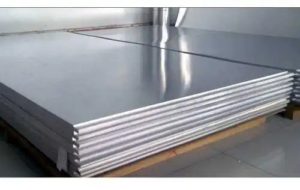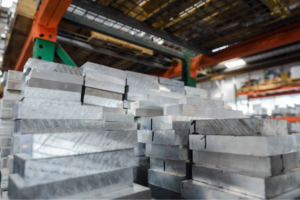Known for its exceptional strength, lightweight nature, and corrosion resistance, aerospace-grade aluminum is the go-to choice for engineers and designers aiming to push the boundaries of what’s possible.
Whether it’s the sleek fuselage of a commercial jet or the intricate components of a spacecraft, aerospace-grade aluminum plays a crucial role in ensuring performance, safety, and efficiency.
In this article, we’ll explore the unique properties and benefits of aerospace-grade aluminum and why it remains the top choice for high-performance applications in the aerospace industry.
What Is Aerospace Grade Aluminum?
Aerospace-grade aluminum refers to a category of aluminum alloys specifically designed and optimized for use in the aerospace industry. These alloys include aluminum grades such as 2024, 6061, 7050, and 7075.
These aerospace aluminum alloys are known for their exceptional strength-to-weight ratio, high corrosion resistance, and overall durability, making them a better choice for high-performance applications than common aluminum alloys.
The aerospace industry demands materials that can withstand extreme conditions, such as high stress, wide temperature ranges, and exposure to corrosive environments.
Aerospace-grade aluminum meets these stringent requirements and is used extensively in aircraft, spacecraft, and other high-performance vehicles.
Key Properties of Aerospace-Grade Aluminum

Aerospace-grade aluminum is a marvel of modern engineering, and it’s no wonder it’s the go-to material for high-performance applications in the aerospace industry.
Let’s dive into the key properties that make this material so special.
Exceptional Strength-to-Weight Ratio
One of the standout features of aerospace-grade aluminum is its impressive strength-to-weight ratio. This means it offers maximum strength while remaining lightweight, which is crucial for aircraft components.
The lighter the aircraft, the more fuel-efficient it becomes, leading to cost savings and reduced environmental impact.
For instance, aluminum alloys like 7075 and 2024 are known for their high tensile strength, making them ideal for critical structural components.
High Corrosion Resistance
Aerospace-grade aluminum is highly resistant to corrosion, which is essential for the longevity and safety of aircraft. This property ensures that the material can withstand harsh environmental conditions, such as exposure to moisture and varying temperatures, without degrading. Its excellent corrosion resistance also makes it suitable for marine applications.
Adding elements like zinc, magnesium, and copper to specific alloys enhances this resistance, making them suitable for modern aircraft wings and fuselages.
Effective Thermal and Electrical Conductivity
Aluminum is an excellent conductor of heat and electricity. This property is particularly beneficial in aerospace applications requiring efficient heat dissipation.
For example, aluminum is often used to construct aircraft heat exchangers and cooling systems. Its ability to conduct electricity makes it worthwhile in electrical wiring and components.
Excellent Fatigue Resistance
Aircraft are subjected to repeated stress and strain during takeoff, flight, and landing.
Aerospace-grade aluminum exhibits excellent fatigue resistance, meaning it can endure these cyclic loads without cracking or failing better than other aluminum grades. This property is vital for ensuring the structural integrity and safety of the aircraft over its operational life. It can also save the aircraft construction industry money from frequent maintenance.
Malleability and Machinability
Aerospace-grade aluminum is highly malleable and machinable, allowing it to be easily formed into complex shapes and components. This flexibility in manufacturing is a significant advantage, as it enables the production of intricate parts with tight tolerances. This helps create highly specific aerospace parts for space shuttles and the International Space Station.
Techniques such as extrusion, rolling, and forging are commonly used to shape aluminum into the desired forms.
Recyclability
Sustainability is becoming increasingly important for aerospace applications, and aluminum’s recyclability is a significant plus.
Aerospace-grade aluminum can be recycled without losing its properties, making it an environmentally friendly choice compared to other aluminum grades.
Recycling aluminum requires about 5% of the energy needed to produce new aluminum products, further reducing the carbon footprint of aerospace applications.
Compatibility with Advanced Manufacturing Techniques
The aerospace industry is continually evolving, and so are the manufacturing techniques. Aerospace-grade aluminum is compatible with advanced manufacturing methods such as additive manufacturing (3D printing).
This compatibility allows for the creation of lightweight, high-strength aerospace components with complex geometries that would be challenging to produce using traditional aerospace engineering.
Benefits of Aerospace-Grade Aluminum
| New Aluminum Cast Plate | New Aluminum Plate | Verified Remnant Aluminum Cast Plate |
 |
 |
 |
|
|
|
Aerospace-grade aluminum offers a range of benefits that make it ideal for high-performance applications.
Let’s discuss some of the benefits below.
Fuel Efficiency
The lightweight nature of aerospace-grade aluminum contributes significantly to fuel efficiency.
Lighter aircraft require less fuel to operate, reducing operational costs and minimizing the environmental impact.
Maintenance and Longevity
The durability and high corrosion resistance of aerospace-grade aluminum mean that aircraft components from this material require less frequent maintenance and longer service life. This reliability is crucial for the safety and economic efficiency of airline operations.
Versatility in Design
Aerospace-grade aluminum can be easily machined, formed, and welded, allowing for complex and precise designs. This versatility enables engineers to create innovative and efficient aircraft structures.
| Did You Know? Aluminum is the most plentiful metal in the Earth’s crust, but it wasn’t until the 1800s that elemental aluminum was successfully extracted. |
Applications of Aerospace-Grade Aluminum in Aircraft
Aerospace-grade aluminum is a superstar in the aviation world, and for good reason. Its unique properties make it an ideal material for various aircraft components, contributing to both performance and safety.
Let’s dive into where this remarkable material is commonly used in aircraft.
Aircraft Wings and Fuselage
The fuselage, the aircraft’s main body, and the wings are two of the most critical structural components.
Aerospace-grade aluminum is often the material of choice here due to its excellent strength-to-weight ratio. This means it can withstand the stresses of flight. Its lightweight properties also boost fuel efficiency and overall performance.
Aircraft Engines
While you might think of engines as being entirely made of steel or titanium, aerospace-grade aluminum also plays a significant role.
Components such as fan blades and casings often use aluminum alloys. These parts benefit from aluminum’s lightweight properties, which help improve the engine’s efficiency and performance.
Landing Gear
The landing gear is another area where aerospace-grade aluminum products shine. The material’s strength and durability are essential for withstanding the impact and stress of takeoff and landing.
Additionally, its high corrosion resistance ensures that the landing gear remains reliable over time, even in harsh environmental conditions.
Interior Components
Aerospace-grade aluminum is used for various structural components inside the aircraft, including seat frames, overhead bins, and even some cockpit parts.
Its lightweight properties help reduce the aircraft’s overall weight, contributing to better fuel efficiency.
Its high corrosion resistance ensures that these components remain in good condition throughout the aircraft’s lifespan.
Electrical Systems
Aerospace-grade aluminum is also used in the aircraft’s electrical systems.
Its excellent conductivity makes it ideal for wiring and other electrical components, ensuring that the aircraft’s electrical systems are efficient and reliable.
| Fun Fact: Aluminum is infinitely recyclable, and almost 75% of all aluminum ever produced is still in use today. |
|
Top-Grade Aluminum for Every Purpose and Industry |
||
|
New Aluminum Plate 6061 |
New Aluminum Rectangular Bar |
All Aluminum Shapes |
 |
 |
 |
| Customizable thickness: Measure in inches. You can get various options for all industry applications.Can be cut to specific shapes and sizes: Excellent weldability to cater to unique project needs.
Corrosion resistance: Grades like 6061-T651 are perfect for marine hardware applications that require superior rust resistance. |
Environmental resilience: Due to its heat treatable nature, 6061 aluminum does well in extreme conditions.Wide selection of sizes and dimensions: Choose your sizes based on tensile strength, width, and weight.
Good machinability: It’s lightweight and high strength makes it flexible for a number of applications. |
Reliable supply: Consistent, certified aluminum stock you can trust.High-quality material: Superior-grade aluminum for precision needs.
Custom cuts: Accurate cuts down to thousandths of an inch. |
Challenges of Using Aerospace-Grade Aluminum
Aerospace-grade aluminum is a marvel of modern engineering, but like any material, it has its own set of challenges.
Understanding these challenges is crucial for manufacturers and engineers who rely on this high-performance material.
Fatigue and Fracture
Aerospace parts are subjected to repeated stress cycles, which can lead to fatigue over time. This is particularly concerning for parts such as aircraft wings and fuselage sections that experience constant pressure changes during flight.
Engineers must carefully design these components to distribute stress evenly and minimize the risk of fatigue-related failures.
Cost
Aerospace-grade aluminum alloys, such as the famous 7075 and 2024, are more expensive than common aluminum alloys. This higher cost is due to the stringent manufacturing processes and quality control measures required to meet aerospace industry standards.
For instance, the alloying elements like zinc, copper, and magnesium used in these grades are costly, and the precision required in their production adds to the expense.
Environmental Considerations
The production of aerospace-grade aluminum is energy-intensive, contributing to a larger carbon footprint than other materials.
Additionally, mining bauxite, the primary ore for aerospace aluminum, can have significant environmental impacts. While aerospace aluminum is highly recyclable, the initial production process remains a concern for sustainability.
How Do Manufacturers Address These Challenges?
Manufacturers face several challenges when working with aerospace aluminum, but they have developed innovative solutions to overcome these obstacles.
Here’s a closer look at how they tackle some of the most common issues.
Improving Fatigue Resistance
Fatigue resistance is crucial for materials used in aerospace applications due to the constant stress and strain they endure. Manufacturers enhance the fatigue resistance of aerospace-grade aluminum through advanced alloying techniques and heat treatments.
By carefully selecting alloying elements such as zinc, magnesium, and copper, they can significantly improve the material’s ability to withstand repeated loading and unloading cycles.
Optimizing Cost-Effectiveness
While aerospace-grade aluminum offers numerous benefits for high-performance aerospace applications, its cost can be a concern. To address this, manufacturers optimize production processes to reduce waste and improve efficiency.
Techniques such as near-net-shape manufacturing, which minimizes the amount of material that needs to be machined away, help reduce costs.
Additionally, manufacturers invest in automated and precision machining technologies to streamline aircraft construction and lower labor costs.
Addressing Environmental Concerns
Manufacturers are committed to reducing the environmental impact of aerospace-grade aluminum production and usage. They implement recycling programs to reclaim aluminum alloys from end-of-life aircraft and manufacture scrap.
Recycling aluminum products requires only a fraction of the energy needed to produce new aluminum, making it an environmentally friendly option.
Additionally, manufacturers are exploring greener alloying elements and production methods to reduce their carbon footprint further.
| Fun Fact: Modern air and space flight would not be possible without the development of aluminum alloys that combine lightweight properties with high strength. |
Latest Advancements in Aerospace-Grade Aluminum
Aerospace-grade aluminum has long been a cornerstone in the aerospace industry, thanks to its unique combination of properties that make it ideal for high-performance aerospace applications.
Recent advancements in this field have only enhanced its appeal, making it even more indispensable in aircraft construction.
Let’s dive into some of the latest innovations and how they shape the future of aerospace engineering.
Nanotechnology Enhancements
Nanotechnology is another frontier that is revolutionizing aerospace aluminum alloys. By incorporating nanoparticles into aluminum alloys, researchers have been able to improve their mechanical properties significantly.
These nanoparticles can enhance the material’s strength, toughness, and resistance to wear and tear. This means that aircraft components made from these advanced materials can withstand more stress and last longer, reducing the need for frequent replacements and maintenance.
Improved Corrosion Resistance
Recent advancements have led to the development of aerospace-grade aluminum alloys with excellent corrosion resistance.
Without degrading, these new materials can withstand extreme conditions, such as high humidity and saltwater exposure. This makes it suitable for a variety of uses, including marine applications. This also extends the lifespan of the components and enhances the overall safety and reliability of the aircraft and its structural components.
Smart Materials
Integrating smart materials into aerospace-grade aluminum can change their properties in response to external stimuli, such as temperature or stress.
For example, some smart aluminum alloys can self-heal minor cracks, preventing them from developing into more significant issues. This capability can drastically reduce maintenance costs and improve aircraft safety.
Enhanced Thermal Management
Recent advancements have led to the development of aluminum alloys with improved thermal conductivity. These materials can more effectively dissipate heat, preventing overheating and enhancing the performance of critical systems.
This is particularly important for aerospace components such as engine parts and electronic systems, where efficient thermal management is crucial.
Embrace the Future of Aerospace With Aluminum
Aerospace-grade aluminum is an essential material in the aerospace industry due to its remarkable properties and versatile applications. Its strength, lightweight nature, and resistance to harsh environments make it ideal for critical aerospace components.
Despite challenges such as cost and environmental impact, continuous advancements and innovative solutions ensure that aerospace-grade aluminum remains at the forefront of high-performance engineering and aircraft construction.
As the aerospace sector evolves, ongoing improvements in aluminum alloys promise even greater efficiency, safety, and sustainability in the future. At Industrial Metal Service, we have new aluminum and verified remnant aluminum in our huge metal inventory, serving the aerospace industry and beyond.
By embracing our products and these industry advancements, manufacturers and engineers can continue to push the boundaries of what is possible, achieving new heights in aerospace innovation.
 Angle
Angle Cast Plate
Cast Plate Diamond Plate
Diamond Plate Flat Bar
Flat Bar Plate
Plate Round Bar
Round Bar Square Bar
Square Bar Square Tubing
Square Tubing Round Tubing
Round Tubing Angle
Angle Channel
Channel Diamond Plate
Diamond Plate I Beam
I Beam Round Bar
Round Bar Sheet
Sheet Square tubing
Square tubing Round Tubing
Round Tubing Rectangular Tubing
Rectangular Tubing Plate
Plate Rectangular Bar
Rectangular Bar Rectangular Tubing
Rectangular Tubing Round Bar
Round Bar Sheet
Sheet Square Bar
Square Bar Square Tubing
Square Tubing
